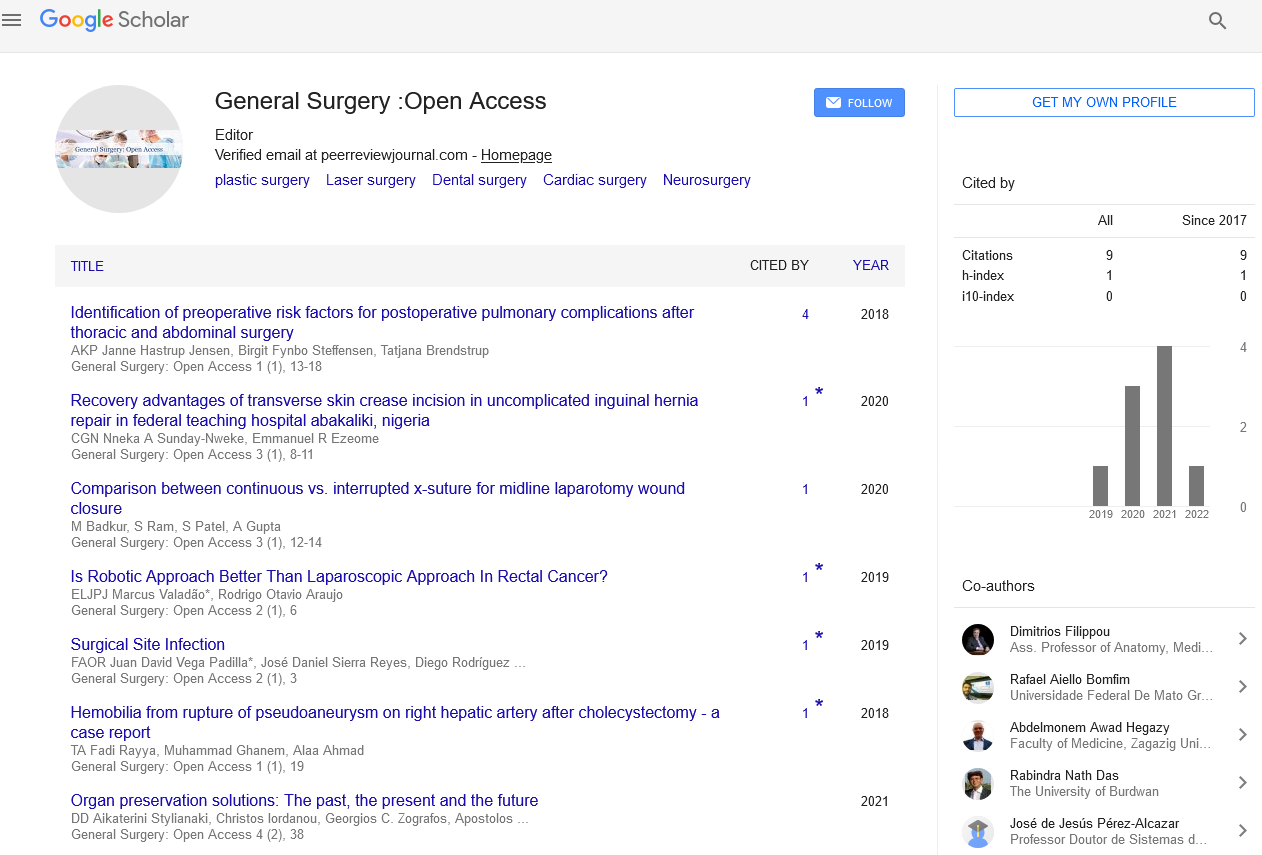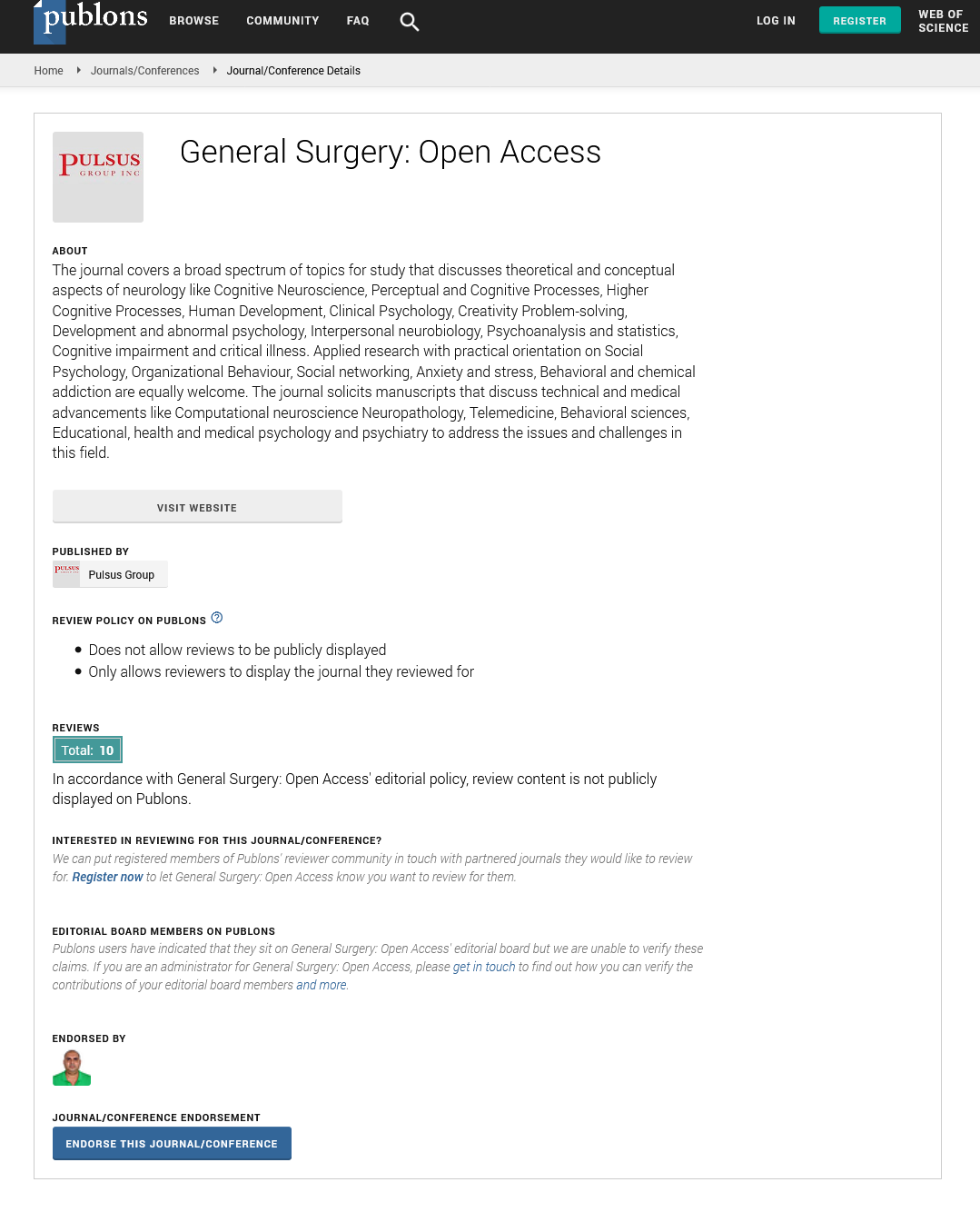Assessment of the effects of three phytochemicals on the white blood cell count
Received: 03-Jan-2023, Manuscript No. PULGSOA-23-6286; Editor assigned: 08-Jan-2023, Pre QC No. PULGSOA-23-6286(PQ); Reviewed: 18-Jan-2023 QC No. PULGSOA -23-6286(Q); Revised: 04-Feb-2023, Manuscript No. PULGSOA -23-6286(R); Published: 14-Feb-2023
Citation: Denial S, Assessment of the effects of three phytochemicals on the white blood cell count. Gen Surg: Open Access. 2023;6(1)7- 8.
This open-access article is distributed under the terms of the Creative Commons Attribution Non-Commercial License (CC BY-NC) (http://creativecommons.org/licenses/by-nc/4.0/), which permits reuse, distribution and reproduction of the article, provided that the original work is properly cited and the reuse is restricted to noncommercial purposes. For commercial reuse, contact reprints@pulsus.com
Abstract
Nigella Sativa (NS), Thymoquinone (TQ), and Epigallocatechin-3-Gallate (EGCG) are phytochemicals that might have antioxidant protective potentials on the hamster cheek pouch epithelium (HCPE). We aimed at evaluating and comparing the potential therapeutic outcomes of these 3 phytochemicals by analysis of peripheral White Blood Cell (WBCs) counts. NS whole oil, TQ, and EGCG were administered before, with, or after 7,12-Dimethylbenza[A]Anthracene (DMBA) painting the hamster's left cheek pouch. Before sacrificing each animal, 2 ml of blood was withdrawn into a fine heparin-containing tube to estimate the total WBCs, lymphocytes, MID cells, and granulocytes counts by an automatic count system. All cheek pouches were surgically excised and examined with a light microscope. The three phytochemicals showed different levels of protection against DMBA carcinogenic activity, more specifically, TQ and NS had higher therapeutic potential and might be used for treatment and/or preventive management of oral cancer in the future. However, further investigations are required to address the mechanism of action and feasibility of the clinical application of each phytochemical.
Introduction
oral cancer ranks as the 6th most common type of cancer spreading worldwide and it forms around 25% of cancer types [1]. The first model of oral squamous cell carcinoma (SCC) was produced in the hamster cheek pouch (HCP) using 7,12- Dimethylbenza Anthracene (DMBA), in 1954. This model was extensively used to study the biological pathways, prevention, and treatments of oral SCC [2,3]. Nagini et al. (2009), studied important biologic markers of oral SCC in hamster cheek pouches and humans where they found comparable key signaling pathways. They reported similar oxidative DNA damage, cell survival, and proliferation markers in both humans and hamsters. In addition, apoptosis markers were downregulated while invasiveness and angiogenesis markers were upregulated in both models [3]. This confirms the importance of the HCP carcinogenesis model in studying human oral SCC. Phytochemical agents are widely studied to test their chemopreventive or therapeutic effects on different diseases. Nigella Sativa L whole oil (NS) [4], and one of its active ingredients; Thymoquinone (TQ) [2], are among the most used phytochemicals. An active ingredient of green tea, (–)-Epigallocatechin-3-Gallate (EGCG) [5], is another valuable phytochemical. Researchers consider these agents as antioxidant cytotoxic materials that may prevent, delay, or co-treat malignancies, including ovarian and breast cancer cells [6]. Burits and Bucar (2000) found that NSessential oil and its four constituents (thymoquinone, carvacrol, t-anethole, and 4-terpineol) had antioxidant effects in different chemical assays [7]. Medenica et al. (1997) confirmed that NS extract inhibited endothelial cell progression, decreased production of the angiogenic proteinfibroblastic growth factor made by tumor cells, and inhibited the vascular endothelial growth factor [8]. In a rat model, Nazrul Islam et al.(2004), tested the volatile oil of NS seeds and reported a significant decrease in the antibody titer, splenocytes, and neutrophils counts, but a significant increase in peripheral lymphocytes and monocytes [9]. In addition, NS oil was found to be cytotoxic to fibroblasts and five human cancer cell lines. Thymoquinone (TQ) effects were documented in different health and disease conditions [9]. The effect of oral TQ and its metabolite (dihydro-TQ) on hepatic, renal, and cardiac antioxidant enzyme activities in healthy mice. They provided evidence that TQ and its metabolite acted as superoxide anion and general free radical scavengers which suggests that they might have endogenous antioxidant effects. Green Tea (GT) consumption has been associated with decreased risk of certain human cancers. GTcatechins are reported to have antibiotic, anti-inflammatory, antioxidative, and anticancer effects. GT-catechins intake prevented the experimental tumor metastasis in aged mice via inhibition of reduction in immune surveillance potential with aging. The GT polyphenolic compounds, especially catechins, may act as antioxidants, free radical scavengers, and stimulants of the detoxification systems through selective induction or modification of phase I and II metabolic enzymes. In addition, GT polyphenols may inhibit neoplasms growth and development via the inhibition of some biochemical components involved in tumor initiation and cell proliferation. The green tea decreased neoplasms number by 35.1% and volume by 41.6% when given for 18 weeks following 6 weeks of DMBA treatment in golden hamsters. The GT active ingredient EGCG may sensitize breast cancer cells to paclitaxel chemotherapy, both in vitro and in vivo. Peripheral blood contains a large pool of circulating leukocytes that perform a multitude of functions and are used for the diagnosis and treatment of many diseases, including cancer. Circulating cells include lymphocytes, neutrophils, eosinophils, basophils, monocytes, and other less abundant cells. This study aimed to compare the immune-boosting potential of Nigella Sativa, thymoquinone, and epigallocatechin-3-gallate against the carcinogenic effect of 7,12-dimethylbenza[a]anthracene on hamster cheek pouch epithelium, through evaluation of different peripheral white blood cells.
Conclusions
In this study, DMBA resulted in severe epithelial dysplasia and a significant reduction of total WBCs and lymphocyte counts when given for 6 weeks either alone or after administration of either phytochemical. At the local level, Thymoquinone (TQ) showed the best chemotherapeutic potential for the chemically induced malignant transformation in this HCPE-DMBA model. This was evident when TQ was given either for 2 weeks before DMBA or for 6 weeks after 6 weeks of DMBA administration. Nigella Sativa (NS) and Epigallocatechin-3-Gallate (EGCG) showed protective effects when given 2 weeks before DMBA, then continued with DMBA for 6 weeks. However, EGCG was superior to NS in significantly elevating total WBCs and lymphocyte counts. At the blood level, NS or TQ alone showed significant elevations of lymphocyte count compared to EGCG, DMBA, or healthy controls. In addition, NS and TQ showed a significant elevation of total WBCs count as compared to the DMBA group. This DMBA-hamster carcinogenesis model can be used to further study SCC mechanism, and pathogenesis and develop new diagnostic markers. In addition, these three phytochemicals may be employed in the invention and advancement of SCC chemotherapy or immunotherapy.
References
- Sun Y, Ren J, Wang F. [6]-Gingerol impedes 7, 12-dimethylbenz (a) anthracene-induced inflammation and cell proliferation-associated hamster buccal pouch carcinogenesis through modulating Nrf2 signaling events. J Biochem Mol Toxicol. 2021:35(4):22689.
- El-Dakhakhny M, Hassan MA, Abdel-Aziz G. Effect of thymoquinone and poly-thymoquinone on chemicallyinduced oral epithelial dysplasia (experimental study),(Part I). Intern J Acad Res. 2009:1(2):107.
- Nagini S, Letchoumy PV, Thangavelu A. Of humans and hamsters: a comparative evaluation of carcinogen activation, DNA damage, cell proliferation, apoptosis, invasion, and angiogenesis in oral cancer patients and hamster buccal pouch carcinomas. Oral oncol. 2009:45(6):31-37.
- Khaled AM AJ, Magda AM H. Effect of Nigella sativa oil on the hamster lymphocytes secondary to DMBA-induced carcinogenesis.
- Mukhtar H, Ahmad N. Green tea in chemoprevention of cancer. Toxicol sci: off j Soc Toxicol. 1999:52:111-17.
- Shoieb AM, Elgayyar M, Dudrick PS, Bell JL. In vitro inhibition of growth and induction of apoptosis in cancer cell lines by thymoquinone. Int j oncol. 2003:22(1):107-13.
- Burits M, Bucar F. Antioxidant activity of Nigella sativa essential oil. Phytother res. 2000:14(5):323-28.
- Medenica R, Janssens J, Tarasenko A. Anti-angiogenic activity of Nigella sativa plant extract in cancer therapy. InProc Annu Meet Am Assoc Cancer Res. 1997.
- Nazrul Islam SK, Begum P, Ahsan T. Immunosuppressive and cytotoxic properties of Nigella sativa. Phytother Res: Int J Devoted Pharmacol Toxicol Eval Nat Prod Deriv. 2004: 18(5):395-98.






